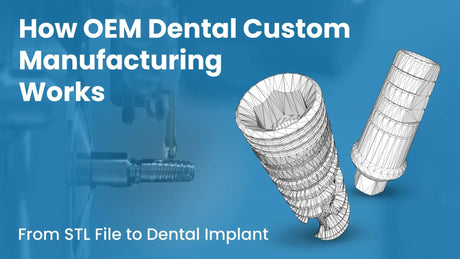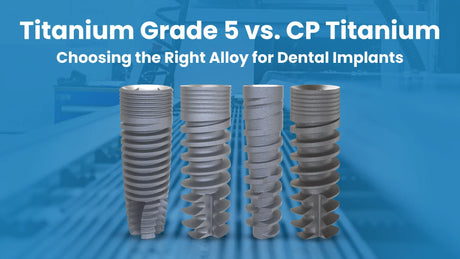

Straight vs. Shoulder: Choosing the Perfect Abutment
In this OEMDent.com article, we delve into the nuanced world of dental abutments, specifically focusing on Straight Abutments and Shoulder Abutments. Both play crucial roles in the success of dental implants, ensuring stability, aesthetics, and long-term functionality. Understanding their similarities and differences is vital for dental professionals and patients alike, as it informs better decision-making in treatment plans. This article explores the characteristics, uses, and unique benefits of each type of abutment, highlighting why each is designed to fulfill its specific role.
General Description
Straight abutments and shoulder abutments are fundamental components in dental implantology, serving as the connecting structures between the implant and the final prosthesis. Straight abutments, as the name suggests, feature a simple, cylindrical design that aligns directly with the implant. They are often used in cases where the implant is perfectly aligned with the prosthetic crown. Shoulder abutments, on the other hand, include a flared or angled shoulder that provides additional support and a broader base for the prosthetic crown. This design is particularly beneficial when dealing with implants that require a more substantial support structure due to the positioning or angulation of the implant.
Similarities and Mutual Uses
Both straight and shoulder abutments share several characteristics that make them indispensable in modern dental implantology. Firstly, both are crafted from high-grade materials, with Titanium Grade 5 (Ti 6Al 4V ELI) being the most prevalent due to its superior strength, biocompatibility, and resistance to corrosion¹. This material ensures that both types of abutments can withstand the forces exerted during chewing and other oral functions, contributing to the longevity and success of the implant².
In terms of functionality, both types of abutments serve the critical purpose of securely anchoring the prosthetic crown to the implant, providing a stable foundation that mimics the natural tooth structure. Additionally, both abutments can be used in various clinical situations, including single-tooth replacements and full-arch restorations, depending on the specific requirements of the case³.
Differences and Uniqueness
While straight and shoulder abutments share common ground, their differences lie in their specific applications and the clinical scenarios they are best suited for. Straight abutments are typically used when the implant is placed in an ideal position, where minimal modification is required to achieve the desired prosthetic outcome. Their simplicity makes them easy to use and highly versatile, often chosen for straightforward cases where the implant is perfectly aligned with the prosthesis⁴.
Shoulder abutments, however, are specially designed to address more complex scenarios. The flared shoulder provides a broader base for the crown, which is particularly useful when the implant is placed at an angle or when additional support is needed to accommodate larger prosthetics. This design not only enhances the stability of the implant but also improves the aesthetic outcome by providing better tissue support and a more natural emergence profile⁵.
Furthermore, shoulder abutments are often favored in anterior restorations where aesthetic considerations are paramount. The broader base allows for a more natural contouring of the soft tissues around the implant, leading to a more pleasing visual result⁶.
Conclusion
In this OEMDent.com article, we've explored the critical roles that straight and shoulder abutments play in dental implantology. While both share the fundamental purpose of anchoring the prosthetic crown, their differences make each uniquely suited for specific clinical scenarios. Straight abutments offer simplicity and versatility, ideal for cases with ideal implant positioning. Shoulder abutments, with their flared design, provide enhanced support and aesthetic benefits, particularly in more complex restorations. Understanding these nuances helps ensure that each patient receives the most suitable and effective treatment, ultimately leading to better outcomes in dental care.
- NIH: The Effect of Abutment Angulation and Crown Material Compositions on Stress Distribution in 3-Unit Fixed Implant-Supported Prostheses: A Finite Element Analysis
- ScienceDirect: Dental Abutment
- NIH: Stress distribution around different abutments on titanium and CFR-PEEK implant with different prosthetic crowns under parafunctional loading: A 3D FEA study
- Scientific.Net: Analysis of the Pullout Testing of Straight and Angled Abutments in Narrow Diameter Implants
- NIH: Influence of shoulder coverage difference of abutment on stress distribution and screw stability in tissue-level internal connection implants: A finite element analysis and in vitro study
- NIH: Survival and Success Rates of Different Shoulder Designs: A Systematic Review of the Literature

OEMDent.com offers uncompromised quality, cost-effective dental implants & prosthetics compatible with leading implant systems. We go beyond manufacturing, offering OEM & Private Label services to meet your dental needs.






